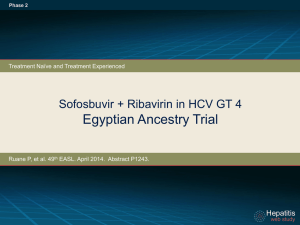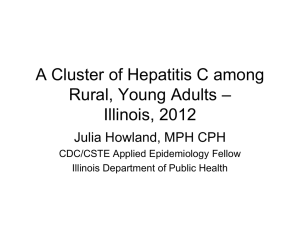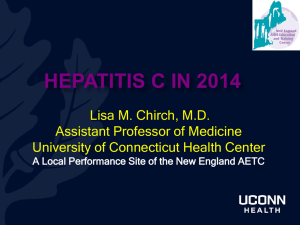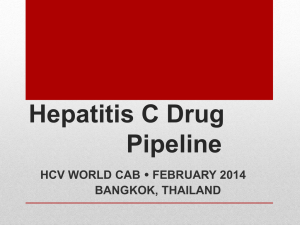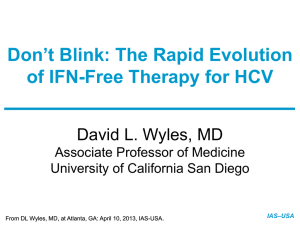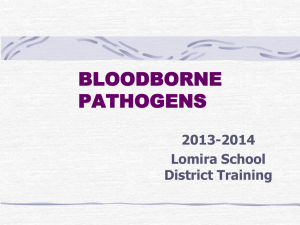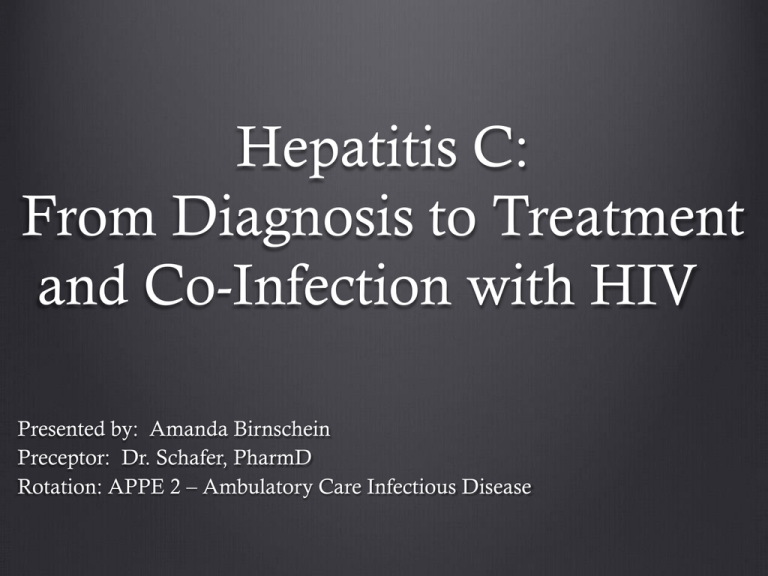
Hepatitis C:
From Diagnosis to Treatment
and Co-Infection with HIV
Presented by: Amanda Birnschein
Preceptor: Dr. Schafer, PharmD
Rotation: APPE 2 – Ambulatory Care Infectious Disease
Guess What Today Is?.....
World Hepatitis Day!
Centers for Disease Control and Prevention. Available at: http://www.cdc.gov. Accessed July 25, 2014.
Background
What is Hepatitis C?
Contagious liver disease that stems from HCV and ranges in
severity
Mild illness lasting
a few weeks
serious, lifelong
illness that attacks
the liver
Centers for Disease Control and Prevention. Hepatitis C information for health professionals. Available at:
http://www.cdc.gov/hepatitis/C/cFAQ.htm#statistics. Accessed July 25, 2014.
Pop Quiz: Epidemiology
What is the prevalence of chronic HCV infection in the
United States?
a) ~ 99,000
b) ~ 3.2 million
c) ~ 6 million
d) ~ 1 billion
Centers for Disease Control and Prevention. Hepatitis C information for health professionals. Available at:
http://www.cdc.gov/hepatitis/C/cFAQ.htm#statistics. Accessed July 25, 2014.
Epidemiology: HCV
An estimated 3.2 million persons in the United States have
chronic HCV
Most people do not know they are sick
Most prevalent among those born during 1945 – 1965
Infected in the ’70s and ‘80s when rates were the highest
Only 849 cases of confirmed acute HCV were reported in
2007
~17,000 new infection occurred that year
In 2007, there were 15,106 deaths caused by HCV
HCV is the most common blood-borne pathogen
Centers for Disease Control and Prevention. Hepatitis C information for health professionals. Available at:
http://www.cdc.gov/hepatitis/C/cFAQ.htm#statistics. Accessed July 25, 2014.
Epidemiology: HCV Coinfection with HIV
~ ¼ of HIV-infected individuals in U.S. are also infected with
HCV
Co-infection is higher (~80%) among IV drug users since
both infections are passed through the blood
HCV progresses more rapidly in HIV infected individuals
More than triples the risk for liver disease, liver failure, and liverrelated death from HCV
Liver disease has become the leading cause of non-AIDS
related deaths in the HIV population
Centers for Disease Control and Prevention. HIV and Viral Hepatitis. Available at: http://www.cdc.gov/hepatitis/Populations/PDFs/HIVandHepFactSheet.pdf . Accessed July 27, 2014.
HCV & HIV Co-infection:
Increased Risk of Death
Branch AD, et al. CID. 2012;55:137-144.
Pop Quiz: HCV Cell Life Cycle
What is one major difference in terms of cell life cycle that is
different between HCV and HIV?
a) The HCV does not need to enter the liver cell in order to replicate
b) HCV does not have budding of an immature virus
c)
HCV does not have reverse transcriptase step in the life cycle,
leading to no integration into the nucleus
d) There are no major differences, HCV and HIV have the same life
cycle
HCV Life Cycle
① Viral attachment and entry
② Fusion and viral RNA
Release
③ Translation and production
of polyprotein precursors
④ Cleavage of polyprotein into
functional and structural
proteins
⑤ Formation of the RNA
replication complex
⑥ RNA replication
⑦ Viral assembly, budding, and
release
The AIDS InfoNet. Available at:
http://www.aidsinfonet.org/fact_sheets/view/670. Accessed:
Patient Case
HPI: A 36 YOM referred to the liver clinic by his primary care
physician for assessment of his abnormal liver enzymes. Patient has
been noticing that he is fatigued and has had a decrease in his appetite.
Until his primary care appointment, he didn’t realize that he lost 13
pounds over the past two months. He does not have any past history
of liver problems.
PMH: GERD, Seasonal allergies, IV drug use during late teens
FM: No known family history of liver problems. Parents died in car
accident 18 years ago.
SH: Married for 11 years; one child aged six years old. Non-smoker,
denies illicit drug use, social drinker 1-2 times per week with
approximately 2-3 beers at a time. He currently works as a
phlebotomist at a local hospital.
ROS: Non-specific symptoms such as fatigue and weight loss, but
denies any other symptoms of liver disease.
Meds: Omeprazole 20 mg PO daily, loratadine 10 mg PO daily PRN
seasonal allergies
VS: BP 110/72, P 70, RR 17, T 37.0 C, Wt 168 lbs, Ht 5’11”
Skin: no jaundice
HEENT: PEERLA, EOMI, sclera anicteric
Abd: No hepatomegaly or splenomegaly present. No evidence of
ascites.
Extremities: No edema, normal ROM
Neuro: A&O x 3, CN II-XII intact
Labs (obtained during PCP visit):
AST 186 IU/L
ALT 197 IU/L
T bili 1.5 mg/dL
Alb 3.5 g/dL
HIV (-)
HBsAg (-)
Angi-HAV (-)
Anti-HCV (+)
HCV RNA 4.6 million copies/mL
PT 12.5 sec
Liver biopsy today: moderate degree of fibrosis and inflammation consistent with
chronic hepatitis
Risk Behaviors
Most common methods to become infected
Sharing needles, syringes, or other equipment to inject drugs
Intranasal illicit drug use
Less commonly
Sharing personal care items that may have come in contact with
blood, such as razors or toothbrushes
Have sexual contact with a person infected with HCV
American Association for the Study of Liver Diseases/Infectious Diseases Society of America, with International Antiviral Society–USA. Recommendations for
testing, managing, and treating hepatitis C. Available at: http://www.hcvguidelines.org/full-report-view. Accessed July 24, 2014.
Centers for Disease Control and Prevention. Hepatitis C information for health professionals. Available at:
http://www.cdc.gov/hepatitis/C/cFAQ.htm#statistics. Accessed July 25, 2014.
Risk Exposures
Long-term hemodialysis
Getting a tattoo in an unregulated setting
Healthcare, emergency medical, and public safety workers after needle
sticks, sharps, or mucosal exposures to HCV-infected blood
Children born to HCV-infected women
Prior recipients of transfusions or organ transplants, including persons
who:
Were notified they received blood from someone who later tested positive
Blood transfusion or organ transplant before July 1992
Received clotting factor concentrates produced before 1987
Were ever incarcerated
Other Medical Conditions
HIV infection
Unexplained chronic liver disease and chronic hepatitis
American Association for the Study of Liver Diseases/Infectious Diseases Society of America, with International Antiviral Society–USA. Recommendations for
testing, managing, and treating hepatitis C. Available at: http://www.hcvguidelines.org/full-report-view. Accessed July 24, 2014.
Symptoms
Pain in the right upper
abdomen
Abdominal swelling due
to fluid (ascites)
Clay-colored or pale
stools
Dark urine
Fatigue
Fever
Itching
Jaundice
Loss of appetite
nausea and vomiting
Joint pain
PubMed health. Hepatitis C. Available at: http://www.ncbi.nlm.nih.gov/pubmedhealth/PMH0001329/. Accessed July 25, 2014.
Centers for Disease Control and Prevention. Available at: http://www.cdc.gov/hepatitis/C/cFAQ.htm#statistics. Accessed July 25, 2014.
Who Should be Tested?
HCV testing is recommended in select populations based on:
Demography
Primary exposures
High-risk behaviors
Medical conditions
1.
1.
2.
At least once for persons born between 1945 and 1965
Annual testing:
a. Person who inject drugs
b. HIV-seropositive men who have unprotected sex with men
Periodic testing to persons with ongoing risk factors for exposure to HCV
American Association for the Study of Liver Diseases/Infectious Diseases Society of America, with International Antiviral Society–USA. Recommendations for
testing, managing, and treating hepatitis C. Available at: http://www.hcvguidelines.org/full-report-view. Accessed July 24, 2014.
Diagnosis
* Exposure within the
past 6 months, testing for
HCV RNA or follow-up
testing for HCV antibody
should be performed
* Those that are immune
compromised, testing for
HCV RNA should be
performed
† To differentiate past,
resolved HCV infection
from biologic false
positivity for HCV
antibody, testing with
another HCV antibody
assay can be considered
American Association for the Study of Liver Diseases/Infectious Diseases Society of America, with International Antiviral Society–USA. Recommendations for
testing, managing, and treating hepatitis C. Available at: http://www.hcvguidelines.org/full-report-view. Accessed July 24, 2014.
What is missing for MJ’s
diagnosis?
Genotype!
Guidelines recommend:
Testing for HCV genotype to guide selection of the most
appropriate antiviral
There are at least 6 different HCV genotypes with over 50
different subtypes
Genotype 1 is the most common in the United States
Treatment varies depending on genotype
Determines likelihood of treatment response and duration of
treatment
Centers for Disease Control and Prevention. Hepatitis C information for health professional. Available at: http://www.cdc.gov/hepatitis/HCV/HCVfaq.htm.
Accessed July 25, 2014.
Genotypes in the World
Center for Disease Analysis. Hepatitis C. Available at: http://www.centerforda.com/Maps/World%20P.jpg. Accessed July 26, 2014.
Genotype in the United States
Center for Disease Analysis. Hepatitis C. Available at: http://www.centerforda.com/Maps/World%20P.jpg. Accessed July 26, 2014.
MJ and Genotype
MJ has his genotype tested and finds out he has genotype 1a
Mini Pop Quiz: Anything else we could ultimately to test for?
1) Q80K polymorphism
2) IL-28B gene
3) K103N mutation
4) Blood sugar
5) 1 & 2
6) All of the above
Non-Pharm Recommendations
Persons with current HCV infection should:
Abstain from alcohol
Be tested for HBV and HIV infections
Evaluation for advanced fibrosis
Liver biopsy, imaging, or non-invasive markers
Vaccination against HAV and HBV
Education on how to avoid HCV transmission to
others
American Association for the Study of Liver Diseases/Infectious Diseases Society of America, with International Antiviral Society–USA. Recommendations for
testing, managing, and treating hepatitis C. Available at: http://www.hcvguidelines.org/full-report-view. Accessed July 24, 2014.
Guidelines & HCV
Treatment:
Sofosbuvir
Simeprevir
Ribavirin
PEG-interferon
Previously in HCV Guidelines
Genotype 1
Treatment
Genotype 2 or 3
Treatment
Peginterferon alfa-2a 180 mcg/wk
Peginterferon alfa-2a 180 mcg/wk
OR
OR
Peginterferon alfa-2b 1.5 mcg/kg/wk
Peginterferon alfa-2b 1.5 mcg/kg/wk
+
+
Ribavirin 1000mg (Wt <75 kg)
OR
Ribavirin 800mg
Ribavirin 1200mg (Wt >75 kg)
+
Telaprevir OR Boceprevir
Ghany MG, et al. Hepatology. 2011;54(4):1433-1444.
HCV Treatment Overview:
Treatment Naïve Patients
Genotype
Recommended Regimen
1
IFN Eligible
SOF + RBV + PEG x 12 weeks
SOF = sofosbuvir
RBV = ribavirin
PEG = peginterferon
SMV = simeprevir
IFN Ineligible
SOF + SMV + RBV x 12 weeks
2
SOF + RBV x 12 weeks
3
SOF + RBV x 24 weeks
4
IFN Eligible
SOF + RBV + PEG x 12 weeks
IFN Ineligible
SOF + RBV x 24 weeks
5 or 6
SOF + RBV + PEG x 12 weeks
American Association for the Study of Liver Diseases/Infectious Diseases Society of America, with International Antiviral Society–USA. Recommendations for
testing, managing, and treating hepatitis C. Available at: http://www.hcvguidelines.org/full-report-view. Accessed July 24, 2014.
HCV Treatment Overview:
Nonresponders
Genotype
Recommended Regimen
1
SOF + SMV + RBV x 12 weeks
2
SOF + RBV x 12 weeks
3
SOF + RBV x 24 weeks
4
SOF + RBV + PEG x 12 weeks
OR
SOF + RBV x 24 weeks
5 or 6
SOF + RBV + PEG x 12 weeks
SOF = sofosbuvir
RBV = ribavirin
PEG = peginterferon
SMV = simeprevir
American Association for the Study of Liver Diseases/Infectious Diseases Society of America, with International Antiviral Society–USA. Recommendations for
testing, managing, and treating hepatitis C. Available at: http://www.hcvguidelines.org/full-report-view. Accessed July 24, 2014.
Remember: What is the key step
for treatment in HCV life cycle?
Cleavage of polyprotein
into functional and
structural proteins
The AIDS InfoNet. Available at:
http://www.aidsinfonet.org/fact_sheets/view/670. Accessed: July 25, 2014
Processing the HCV Polyprotein
Polyprotein precursor
Auto-protease:
Cleaves NS2 –
NS3 junction
Supports
RNA
replication
Becomes HCV RNA
polymerase
Acts as a protease and cleaves
NS4B, NS5A and NS5B
Viral core and
envelope proteins
Picture from: Rosen HR. New Engl J Med. 2011;364(25):2429-2438.
Serves as a helicase function
during RNA replication
Vital component of RNA replication complex
and helps with new virus assembly
Pop Quiz: What is the MOA of
sofosbuvir
1) Entry inhibitor
2) Integrase inhibitor
3) Protease inhibitor
4) Nucleoside analog polymerase inhibitor
Sofosbuvir: Mechanism of
Action
• Prodrug that is converted to its active
form (GS-461203) via intracellular
metabolism
• Inhibits RNA-dependent RNA
polymerase that is essential for viral
replication
• Acts as a chain terminator
Sofosbuvir: Nucleoside analog
polymerase inhibitor
Sovaldi [package insert]. Foster City, CA: Gilead Sciences, Inc.; 2013. Available at: http://www.gilead.com/~/media/Files/pdfs/medicines/liverdisease/sovaldi/sovaldi_pi.pdf.
Neutrino Study
Response
HCV RNA <25 IU/mL – no./total no. (%)
During treatment
Week 2
Week 4
At last observed measurement
After discontinuation of treatment
Week 4
Week 12
Relapse – no./total no. (%)
Patients who completed treatment
Patients who did not complete treatment
Lawitz E, et al. N Engl J Med. 2013;368(20):1878-1887.
SOF+RBV+peg-IFN for 12 weeks
N = 327
299/327 (91)
321/325 (99)
326/327 (>99)
302/327 (92)
295/327 (90)
25/320 (8)
3/6 (50)
Sofosbuvir
Dose: 400 mg PO daily
With or without food
Administered with Peg & Ribavirin
If drugs combined with sofosbuvir must be permanently
discontinued, sofosbuvir should also be discontinued
Drug interactions:
Not metabolized by CYP enzymes, but P-gp substrate
Not recommended to be used with: phenytoin, phenobarbital,
carbamazepine, rifampin, and tipranavir/ritonavir
Adverse effects: Most common include fatigue and headache
Sovaldi [package insert]. Foster City, CA: Gilead Sciences, Inc.; 2013. Available at: http://www.gilead.com/~/media/Files/pdfs/medicines/liverdisease/sovaldi/sovaldi_pi.pdf.
Simeprevir: Mechanism of
Action
• Inhibits NS3/4A protease, a
protease that is essential for
viral replication
• Considered a direct-acting
antiviral treatment for HCV
• Also called a specifically
targeted antiviral therapy for
HCV (STAT-C)
Simeprevir: 2nd generation
protease inhibitor
OlyseoTM [package insert]. Titusville, NJ: Janssen Products, LP; 2013. Available at: https://www.olysio.com/shared/product/olysio/prescribing-information.pdf
Quest-1 & Quest-2
Pooled analysis of simeprevir plus PegIFN/RBV for treatment of
treatment-naïve patients with genotype 1 infection versus PBO/PR:
SVR12 week
SMV +
PEG/
RBV
PBO +
PEG/
RBV
Rockstroh JK. Summary from AASLD 3013 for Hepatitis C. Available at: http://www.natap.org/2013/AASLD/AASLD_109.htm. Accessed July 27, 2014.
Simeprevir
Dosing: 150 mg PO daily
With food
Administered with Peg & Ribavirin
If drugs combined with simeprevir must be permanently
discontinued, simeprevir should also be discontinued
Drug interactions:
Metabolized by CYP 3A4 enzymes and an inhibitor of intestinal
3A4, but NOT hepatic 3A4
Not recommended to be used with: cobicistat, efavirenz, etravirine,
and HIV protease inhibitors
Q80K polymorphism: pretreatment testing on genotype 1a patients
should be considered for simeprevir
Adverse effects: Rash (including photosensitivity), pruritus, and
nausea
OlyseoTM [package insert]. Titusville, NJ: Janssen Products, LP; 2013. Available at: https://www.olysio.com/shared/product/olysio/prescribing-information.pdf
Ribavirin & Peginterferon
Ribavirin
Hemolytic anemia*
Expect 3 g/dL decrease in
Hgb in first 2 – 4 weeks
Caution for CrCl < 50
mL/min
Pregnancy category X
Women of childbearing
age and partners of men
receiving ribavirin MUST
use effective contraception
during and 6 months after
Ribavirin and peginterferon. Lexi-drugs OnlineTM. Lexicomp.
Wolters Kluwer Health, Inc. Hudson, OH. Available at:
http://online.lexi.com.
Peginterferon
Flu-like symptoms
Up to 100% of patients
GI intolerance (20 – 65%)
Anorexia, abdominal pain,
nausea, and vomiting
Neuropsychiatric toxicity (2050%)
Irritability, depression,
confusion, anxiety, insomnia
Neutropenia*
Thrombocytopenia*
* Need to monitor WBCs & platelets (IFN) + RBCs &
Hgb (RBV)
HCV 2014 Guidelines:
Treatment
Dictated by:
Monoinfection with genotype
Treatment experience: nonresponders
Co-infection with HIV
Presence of Cirrhosis
Post-Liver transplant
Renal Impairment
Concomitant medications
American Association for the Study of Liver Diseases/Infectious Diseases Society of America, with International Antiviral Society–USA. Recommendations for
testing, managing, and treating hepatitis C. Available at: http://www.hcvguidelines.org/full-report-view. Accessed July 24, 2014.
HCV Treatment:
Genotype 1 & Treatment Naïve
Recommended
Regimens:
Regardless of
subtype
Alternative Regimens
IFN Eligible*
Sofosbuvir 400 mg PO daily + RBV (1000 mg [<75 kg] to 1200
mg [> 75 kg]) PO daily + PEG weekly x 12 weeks
IFN Ineligible*
Sofobuvir 400 mg PO daily + simeprevir 150 mg PO daily + RBV
(1000 mg [<75 kg] to 1200 mg [> 75 kg]) PO daily x 12 weeks
IFN Eligible & HCV genotype 1b or 1a without Q80K
polymorphism*
Simeprevir 150 mg daily x 12 weeks + RBV (1000 mg [<75 kg] to
1200 mg [> 75 kg]) PO daily + PEG weekly x 24 weeks
IFN Ineligible*
Sofosbuvir 400 mg PO daily + RBV (1000 mg [<75 kg] to 1200
mg [> 75 kg]) PO daily x 24 weeks
*IFN ineligible (1 or more): intolerance to IFN, autoimmune hepatitis, hypersensitivity to PEG,
decompensated liver disease, history of depression or clinical features of depression, a baseline
neutrophil count < 1500/μL, baseline platelet count < 90,000/μL, baseline hemoglobin < 10 g/dL,
or history of preexisting cardiac disease
American Association for the Study of Liver Diseases/Infectious Diseases Society of America, with International Antiviral Society–USA. Recommendations for
testing, managing, and treating hepatitis C. Available at: http://www.hcvguidelines.org/full-report-view. Accessed July 24, 2014.
HCV Treatment:
Genotype 1 & Nonresponders
Recommended
Regimens:
Regardless of subtype
Alternative Regimens:
Regardless of subtype
Regardless IFN Ineligibility & Without HCV PI Nonresponder
Sofosbuvir 400 mg PO daily + simeprevir 150 mg PO daily + RBV
(1000 mg [<75 kg] to 1200 mg [> 75 kg]) PO daily x 12 weeks
With HCV PI Nonresponder
Sofosbuvir 400 mg PO daily x 12 weeks + RBV (1000 mg [<75 kg] to
1200 mg [> 75 kg]) PO daily + PEG weekly x 12 – 24 weeks
With or without an HCV PI Nonresponder & IFN Eligible
Sofosbuvir 400 mg PO daily x 12 weeks + RBV (1000 mg [<75 kg] to
1200 mg [> 75 kg]) PO daily + PEG x 12 – 24 weeks
OR
Without and HCV PI Nonresponder & IFN Eligible
Simeprevir 150 mg PO daily x 12 weeks + RBV (1000 mg [<75 kg] to
1200 mg [> 75 kg]) PO daily + PEG x 48 weeks
IFN Ineligible*
Sofosbuvir 400 mg PO daily + RBV (1000 mg [<75 kg] to 1200 mg [>
75 kg]) PO daily for 24 weeks
American Association for the Study of Liver Diseases/Infectious Diseases Society of America, with International Antiviral Society–USA. Recommendations for
testing, managing, and treating hepatitis C. Available at: http://www.hcvguidelines.org/full-report-view. Accessed July 24, 2014.
HCV Treatment:
Genotype 1 & HIV Co-infection
IFN Eligible: Treatment naïve AND prior relapser
Sofosbuvir 400 mg PO daily + RBV (1000 mg [<75 kg] to 1200 mg
[> 75 kg]) PO daily + PEG weekly x 12 weeks
Recommended
Regimens:
Regardless of
subtype
IFN Ineligible: Treatment naïve
Sofosbuvir 400 mg PO daily + RBV (1000 mg [<75 kg] to 1200 mg
[> 75 kg]) PO daily x 24 weeks
OR
IFN Ineligible: Prior relapser or (treatment naïve)
Sofosbuvir 400 mg PO daily + simeprevir 150 mg PO daily + RBV
(1000 mg [<75 kg] to 1200 mg [> 75 kg]) PO daily x 12 weeks
Treatment experienced: PEG/RBV nonresponse (regardless IFN)
Sofosbuvir 400 mg PO daily + simeprevir 150 mg PO daily + RBV
(1000 mg [<75 kg] to 1200 mg [> 75 kg]) PO daily x 12 weeks
Treatment Experienced: PEG/RBV + Tel or Bos Nonresponse
Treatment as recommended for HCV-monoinfected individuals
American Association for the Study of Liver Diseases/Infectious Diseases Society of America, with International Antiviral Society–USA. Recommendations for
testing, managing, and treating hepatitis C. Available at: http://www.hcvguidelines.org/full-report-view. Accessed July 24, 2014.
PHOTON-1 Trial
On-treatment and sustained virologic response
Sulkowski, et al. JAMA. 2014;312(4):353-361.
MJs Treatment
What would be the best HCV treatment for MJs HCV
monoinfection?
What if MJ was diagnosed with HCV and HIV co-infection,
what would be the best treatment option at this time?
Coming Soon……
When and in whom to initiate therapy:
Target Launch – Summer 2104
Monitoring patients who are on or have completed therapy:
Target Launch – Summer 2014
Management of acute HCV infection:
Target Launch – Summer 2014
American Association for the Study of Liver Diseases/Infectious Diseases Society of America, with International Antiviral Society–USA. Recommendations for
testing, managing, and treating hepatitis C. Available at: http://www.hcvguidelines.org/full-report-view. Accessed July 24, 2014.
In the Pipeline:
Sofosbuvir/Ledipasvir –
LONESTAR Trial
SVR12 results for the different cohorts
S/L - RBV
S/L + RBV
Rockstroh JK. Summary from AASLD 3013 for Hepatitis C. Available at: http://www.natap.org/2013/AASLD/AASLD_109.htm. Accessed July 27, 2014.
Conclusion
Understand the guidelines have certain parameters that
dictate treatment
There are remarkable new treatments available and in the
pipeline
May eliminate need for PEG and even ribavirin in certain
populations
Treatment costs: “Challenges Highlighted For Firm Amid
Surge In Sales Of Hepatitis Medicine.”
Sofosbuvir and simeprevir
References
1.
Centers for Disease Control and Prevention. Available at: http://www.cdc.gov.
Accessed July 25, 2014.
2.
Centers for Disease Control and Prevention. Hepatitis C information for health
professionals. Available at: http://www.cdc.gov/hepatitis/C/cFAQ.htm#statistics .
Accessed July 25, 2014.
3.
Branch AD, Van Natta ML, Vachon ML. Mortality in Hepatitis C Virus-infected
patients with a diagnosis of AIDS in the era of combination antiretroviral therapy.
CID. 2012;55:137-144.
4.
The AIDS InfoNet. Available at:
http://www.aidsinfonet.org/fact_sheets/view/670. Accessed: July 25, 2014.
5.
American Association for the Study of Liver Diseases/Infectious Diseases Society
of America, with International Antiviral Society–USA. Recommendations for
testing, managing, and treating hepatitis C. Available at:
http://www.hcvguidelines.org/full-report-view. Accessed July 24, 2014.
6.
PubMed health. Hepatitis C. Available at:
http://www.ncbi.nlm.nih.gov/pubmedhealth/PMH0001329/. Accessed July 25,
2014.
7.
Center for Disease Analysis. Hepatitis C. Available at:
http://www.centerforda.com/Maps/World%20P.jpg. Accessed July 26, 2014.
References Continued
8.
Ghany MG, Nelson DR, Strader DB, Thomas DL, Seeff LB. An update on
treatment of genotype 1 chronic hepatitis C virus infection: 2011 practice guideline
by the American Association for the Study of Liver Diseases. Hepatology.
2011;54(4):1433-1444.
9.
Rosen HR. Chronic hepatitis C infection. New Engl J Med. 2011;364(25):24292438.
10. Sovaldi [package insert]. Foster City, CA: Gilead Sciences, Inc.; 2013. Available at:
http://www.gilead.com/~/media/Files/pdfs/medicines/liverdisease/sovaldi/sovaldi_pi.pdf. Accessed July 25, 2014.
11. Lawitz E, Mangia A, Wyles D, et al. Sofosbuvir for previously untreated chronic
hepatitis C infection. N Engl J Med. 2013;368(20):1878-1887.
12. OlyseoTM [package insert]. Titusville, NJ: Janssen Products, LP; 2013. Available at:
https://www.olysio.com/shared/product/olysio/prescribing-information.pdf.
Accessed July 27, 2014.
13. Rockstroh JK. Summary from AASLD 3013 for Hepatitis C. Available at:
http://www.natap.org/2013/AASLD/AASLD_109.htm. Accessed July 27, 2014.
14. Ribavirin and peginterferon. Lexi-drugs OnlineTM. Lexicomp. Wolters Kluwer
Health, Inc. Hudson, OH. Available at: http://online.lexi.com. Accessed July 26,
2014.
15. Sulkowski MS, Naggie S, Lalezari J, et al. Sofosbuvir and ribavirin for Hepatitis C
in patients with HIV coinfection. JAMA. 2014;312(4):353-361.
Questions?

